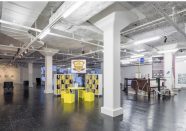 |
Newsletter |
 Dear Reader, When NASA’s spacecraft Viking 1 first landed on planet Mars in 1976, the event opened up the belief that humankind is open to limitless expansion, although it also broke the dream of ever meeting a Martian. But let’s not fool ourselves, it was one of the initial steps into the colonization of space, which also brought our imagination back to terrestrial issues. We live in times when any micro-managed action or even emotion or relation established at the right place and time can potentially be translated into currency or some kind of capital. Do the right thing, learn how to manage your emotions, know the right X number of people, choose your target social setting, reinvent your habitus, capitalize on it. Max Haiven has been howling for a while now that capitalism has colonized how we all imagine and express what is valuable. Hey, we all know we have to be radical in imagining our lives on this fucking planet Earth. Just it isn’t always the case that one life is enough to fight the monsters. Imagination has always been the most powerful tool – either to escape from reality or to make actual alterations of it. Immobilizing circumstances, remote viewing, clairvoyance, imaginative speculations are also some of the conditions and modes of imagining in the screening programme ‘There Was a Forest in the Ceiling’ curated by Rupert’s former resident and curator Erik Martinson. The screening will feature four video-films by Lana Lin, Miko Revereza, Monira Al Qadiri and Basma Alsharif, and a reading of ‘Remote Viewing’, a CIA’s transcript published after the operation Mars Exploration, May 22, 1984, read by our dear residents Johannes Heldén and Rasmus Myrup. In the second part of November, the curator and writer Maria Lind will pay us a visit to give a talk on her current curatorial practices and methodologies. Who else, if not her, having spoken and written so much about social value and collaborative art practices, can remind us of the necessity of radical imagination? So please, if you’re in Vilnius area, join me physically at these events. Otherwise, you know where to find me. x Kah Bee Chow (Malaysia/New Zealand/Sweden) is an artist from Penang, Malaysia and Auckland, New Zealand, living and working in Malmö, Sweden. Whilst at Rupert she will be researching the parallels between traditional forms of divination such as the I Ching and algorithmic forecasting, along with how they diverge in sensibility, correlation and attitudes: what kind of texts and systems they produce to make the unknowable known. She will also investigate the practice of feng shui in relation to the writing of Keller Easterling taking the quote “Human constructs are a form of economic occult” as a starting point. Kah Bee Chow Johannes Heldén G. Adomaityte observes the surrounding environment, the ways materiality meets the digital and looks into the private life-stories of others through artefacts and documents using anthropological and semiotic methods

In Residence
Rasmus MyrupRasmus Myrup is a Danish artist and curator living and working between Paris and Copenhagen. Working primarily with sculpture and drawing, his work is a synthesis of the big and the small investigating humanity’s natural roots in the context of personal human emotions and relations. At Rupert, Myrup will continue his research in to the deep human past, and the time when we shared Europe with the Neanderthals. With this line of research and the local nature surrounding Vilnius, he will produce new works for an exhibition in Paris in early 2020. 
In Residence
Gabrielė AdomaitytėGabrielė Adomaitytė (LT/NL) graduated from Vilnius Art Academy in 2017 and until 2019 Spring had been enrolled in the De Ateliers residency, Amsterdam. In her practice, the artist explores painting’s potential to question forms of visual representation. . At Rupert, the artist will present a project about an archive of experiences and images. She will examine a story and a documentary of one Lithuanian man who had been recording his mundane life through the history of Soviet transport and technology developments. G. Adomaityte observes the surrounding environment, the ways materiality meets the digital and looks into the private life-stories of others through artefacts and documents using anthropological and semiotic methods
|

Screening
9 November, 2019, 5 pm There Was a Forest in the CeilingOn Saturday 9th of November, from 5 pm, Rupert is delighted to invite all to a video screening programme curated by Erik Martinson. The event will take place at the CAC Cinema Hall (Vokiečių str. 2). More info. 
Exhibition Opening
9 November, 2019 Rupert resident Kah Bee Chow is opening her exhibition in the project space “Editorial“, Latako str. 3, Vilnius. The opening will take place on 9th of November, 7 pm. Exhibition is open 09 November – 14 December, 2019. More info. 
Talk
21 November, 2019, 6 pm Maria Lind: About Rolling on Three WheelsRupert, in collaboration with Vilnius Art Academy, is pleased to invite all to a talk by Maria Lind, ‘About Rolling on Three Wheels’ at the Vilnius Academy of Arts November 21st 18.00-19.30. More info. 
In residence
Johannes HeldénJohannes Heldén (SE) is a visual artist, writer and musician. His interdisciplinary works deal with poetry, ecology, artificial intelligence, sentience and narrative structures. At Rupert, he will do research for a project exploring the format of the novel through non-human narratives, science fiction and sound. |
